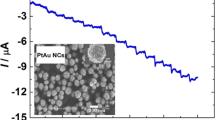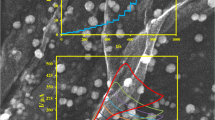Abstract
An ultrasensitive platform is presented for the determination of hydrazine by combining the high specific surface area and higher electrical conductivity of poly(sodium styrenesulfonate) (PSS) graphene nanocomposite film with amperometric detection. The PSS-graphene were synthesized by the Hummers method and used to modify a glassy carbon electrode. The material was characterized by scanning electron microscopy and is found to be suitable for sensing hydrazine. The overpotential of hydrazine on the modified electrode is 0.31 V which is lower than in many electrochemical sensors. The calibration curve for hydrazine is linear in the range from 3.0 to 300 µmol L−1, and the detection limit is as low as 1 µmol L−1. This is the first report in which such a high sensitivity and low limit of detection has been achieved. It is concluded that PSS graphene represents an efficient electron mediator for sensing hydrazine.




Similar content being viewed by others
References
Ahmad U, Rahman MM, Hahn YB (2009) Ultra-sensitive hydrazine chemical sensor based on high-aspect-ratio ZnO Nanowires. Talanta 77:1376
Umar A, Rahman MM, Kim SH, Hahn YB (2008) Chain-like assembly of gold nanoparticles on artificial DNA templates via ‘click chemistry. Chem Commun 2:166
Vernot EH, Macewen JD, Bruner RH, Haus CC, Kinkead ER (1985) Fund Appl Toxicol 5:1050
Mo JW, Ogorevc B, Zhang X, Pihlar B (2000) Cobalt and copper hexacyanoferrate modified carbon fiber microelectrode as an all-solid potentiometric microsensor for hydrazine. Electroanalysis 12:48
Amlathe S, Gupta VK (1988) Spectrophotometric determination of trace amounts of hydrazine in polluted water. Analyst 113:1481
Ensafi AL, Rezaei B (1998) Flow injection determination of hydrazine with fluorimetric detection. Talanta 47:645
Safavi A, Ensa AA (1995) Kinetic spectrophotometric determination of hydrazine. Anal Chim Acta 300:307
Mo JW, Ogorevc B, Zhang X, Pihlar B (2000) Cobalt and copper hexacyanoferrate modified carbon fiber microelectrode as an all-Solid potentiometric microsensor for hydrazine. Electroanalysis 12:48
Ravichandran K, Baldwin RP (1983) Liquid chromatographic determination of hydrazines with electrochemically pretreated glassy carbon electrodes. Anal Chem 55:1782
Ojani R, Raoof JB, Norouzi B (2008) Acetylferrocene modified carbon paste electrode; a sensor for electrocatalytic determination of hydrazine. Electroanalysis 20(12):1378
Wang GF, Gu AX, Wang W, Wei Y, Wu JJ, Wang GZ, Zhang XJ, Fang B (2009) Copper oxide nanoarray based on the substrate of Cu applied for the chemical sensor of hydrazine detection. Electrochem Commun 11:631
Fang B, Shen RX, Zhang W, Wang GF, Zhang CH (2009) Electrocatalytic oxidation of hydrazine at a chromium hexacyanoferrate/single-walled carbon nanotube modified glassy carbon electrode. Microchim Acta 165:231
Yang M, Chen YT, Ma J, Huai LF (2009) Differential pulse voltammetric determination of trace rotenone using molecularly imprinted polymer microspheres. Microchim Acta 166:95
Yang M, Li HL (2002) Differential pulse voltammetric determination of traces of hydrazine using magnetic microspheres. Microchim Acta 138:65
Li J, Lin XQ (2007) Electrocatalytic oxidation of hydrazine and hydroxylamine at gold nanoparticle-polypyrrole nanowire modified glassy carbon electrode. Sens Actuators B 126:527
Christopher BM, Banks CE, Simm AO, Timothy GJ, Richard GC (2006) The electroanalytical detection of hydrazine: a comparison of the use of palladium nanoparticles supported on boron-doped diamond and palladium plated BDD microdisc array. Analyst 131:106
Geim AK, Novoselov KS (2007) The rise of graphene. Nat Mater 6:183
Li D, Muller MB, Gilje S, Kaner RB, Wallace GG (2008) Processable aqueous dispersions of graphene nanosheets. Nat Nanotechnol 3:101
Allen MJ, Tung VC, Kaner RB (2010) Honeycomb carbon: a review of graphene. Chem Rev 110:132
Dikin DA, Stankovich S, Zimney EJ, Piner RD, Dommett GH, Evmenenko G, Nguyen ST, Ruoff RS (2007) Preparation and characterization of graphene oxide paper. Nature 448:457
Stoller MD, Park SJ, Zhu YW, An J, Ruoff RS (2008) Graphene-based ultracapacitors. Nano Lett 8:3498
Stankovich S, Dikin DA, Dommett GHB, Kohlhaas KM, Zimney EJ, Stach EA, Piner RD, Nguyen ST, Ruoff RS (2006) Graphene-based composite materials. Nature 442:282
Xu YX, Bai H, Lu GW, Li C, Shi GQ (2008) Flexible graphene films via the filtration of water-soluble noncovalent functionalized graphene sheets. J Am Chem Soc 130:5856
Muszynski R, Seger B, Kamat PV (2008) Decorating graphene sheets with gold nanoparticles. J Phys Chem C 112:5263
Williarris G, Seger B, Kamat PV (2008) TiO2-graphene nanocomposites. UV-assisted photocatalytic reduction of graphene oxide. ACS Nano 2:1487
Cassagneau T, Fendler JH (1998) High density rechargeable lithium-ion batteries self-assembled from graphite oxide nanoplatelets and polyelectrolytes. Adv Mater 10(11):877
Gilje S, Han S, Wang M, Wang KL, Kaner RB (2007) A chemical route to graphene for device applications. Nano Lett 7:3394
Schedin F, Geim AK, Morozov SV, Hill EW, Blake P, Katsnelson MI, Novoselov KS (2007) Detection of individual gas molecules adsorbed on graphene. Nat Mater 6:652
Bunch JS, van der Zande AM, Verbridge SS, Frank IW, Tanenbaum DM, Parpia JM, Craighead HG, McEuen PL (2007) Electromechanical resonators from graphene sheets. Science 315:490
Lu J, Drzal LT, Worden RM, Lee I (2007) Simple fabrication of a highly sensitive glucose biosensor using enzymes immobilized in exfoliated graphite nanoplatelets nafion membrane. Chem Mater 19:6240
Lu J, Do I, Drzal LT, Worden RM, Lee I (2008) Nanometal-decoratedexfoliated graphite nanoplatelet based glucose biosensors with high sensitivity and fast response. ACS Nano 2:1825
Li J, Guo SJ, Zhai YM, Wang EK (2009) Nafion–graphene nanocomposite film as enhanced sensing platform for ultrasensitive determination of cadmium. Electrochem Commun 11:1085
Wang Y, Li YM, Tang LH, Lu J, Li JH (2009) Application of graphene-modified electrode for selective detection of dopamine. Electrochem Commun 11:889
Shan CS, Yang HF, Song JF, Han DX, Ivaska A, Niu L (2009) Direct Electrochemistry of glucose oxidase and biosensing for glucose based on graphene. Anal Chem 81:2378
Wu H, Wang J, Kang XH, Wang CM, Wang DH, Liu J, Aksay IA, Lin YH (2009) Glucose biosensor based on immobilization of glucose oxidase in platinum nanoparticles/graphene/chitosan nanocomposite film. Talanta online
Fu CL, Yang WS, Chen X, Evans DG (2009) Direct electrochemistry of glucose oxidase on a graphite nanosheet–Nafion composite film modified electrode. Electrochem Commun 11:997
Hummers W, Offeman R (1958) Preparation of graphitic oxide. J Am Chem Soc 80:1339
Liu Y, Zou XQ, Dong SJ (2006) Electrochemical characteristics of facile prepared carbon nanotubes-ionic liquid gel modified microelectrode and application in bioelectrochemistry. Electrochem Commun 8:1429
Pei RJ, Cheng ZL, Wang EK, Yang XR (2001) Amplification of antigen–antibody interactions based on biotin labeled protein–streptavidin network complex using impedance spectroscopy. Biosens Bioelectron 16:355
Ji X, Banks CE, Holloway AF, Jurkschat K, Thorogood CA, Wildgoose GG, Compton RG (2006) Palladium sub-nanoparticle decorated-bamboo multi-walled carbon nanotubes exhibit electrochemical metastability:voltammetric sensing in otherwise inaccessible pH ranges. Electroanalysis 18:2481
Perez EF, Neto GO, Tanaka AA, Kubota LT (1998) Electrochemical sensor for hydrazine based on silica modified with nickel tetrasulfonated phthalocyanine. Electroanalysis 10:112
McAuley CB, Banks CE, Simm AO, Timothy GJJ, Richard GC (2006) The electroanalytical detection of hydrazine: a comparison of the use of palladium nanoparticles supported on boron-doped diamond and palladium plated BDD microdisc array. Analyst 131:106
Abdollah S, Miranzadeh L, Rahman H (2008) Amperometric and voltammetric detection of hydrazine using glassy carbon electrodes modified with carbon nanotubes and catechol derivatives. Talanta 75:147
Richard Prabakar SJ, Sriman Narayanan S (2008) Amperometric determination of hydrazine using a surface modified nickel hexacyanoferrate graphite electrode fabricated following a new approach. J Electroanal Chem 617:111
Acknowledgements
We appreciated the support of the National Science Foundation of China (No. 20871089), the Natural Science Research Project of Education Department of Anhui Province (No. KJ2008B182, KJ2008A06ZC) and the Foundation of Anhui Provincial Education Department for Outstanding young talents in University (No. 2009SQRZ172) and the Natural Science Foundation of Anhui Province (090416239).
Author information
Authors and Affiliations
Corresponding author
Rights and permissions
About this article
Cite this article
Wang, C., Zhang, L., Guo, Z. et al. A novel hydrazine electrochemical sensor based on the high specific surface area graphene. Microchim Acta 169, 1–6 (2010). https://doi.org/10.1007/s00604-010-0304-6
Received:
Accepted:
Published:
Issue Date:
DOI: https://doi.org/10.1007/s00604-010-0304-6




